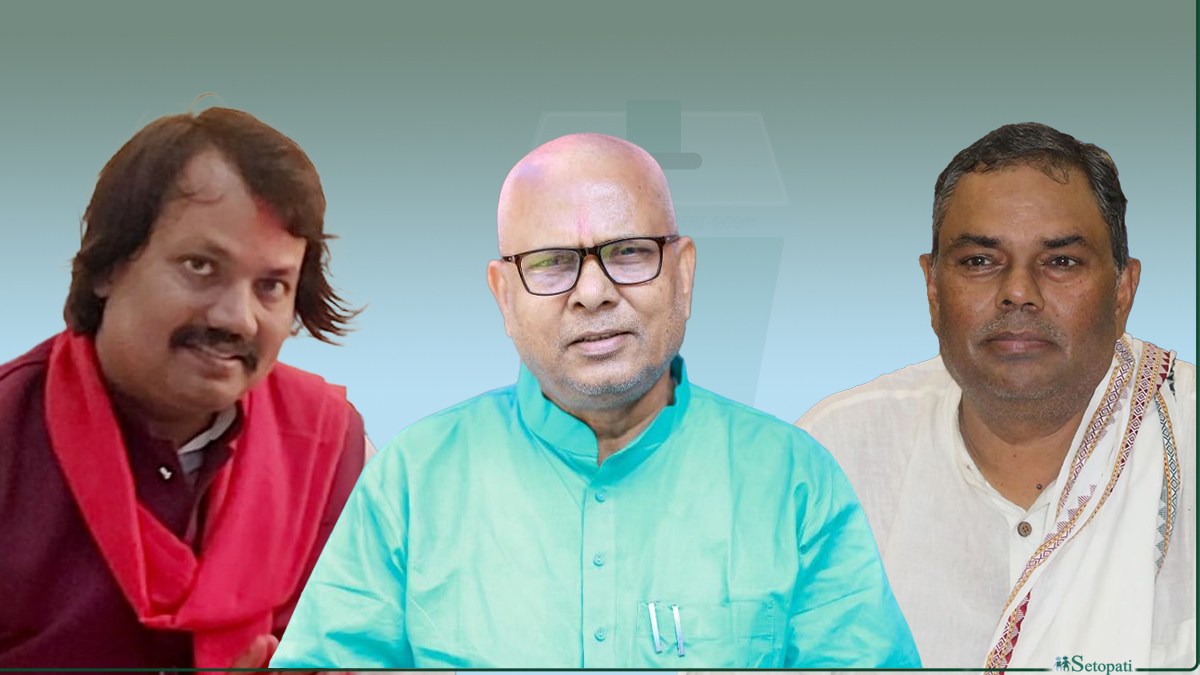Janamat Party founder CK Raut seems ahead of Janata Samajwadi Party (JSP) Chairman Upendra Yadav in the race for the House of Representatives (HoR) in Saptari-2.
Common coalition candidate Jaya Prakash Thakur of Loktantrik Samajwadi Party (LSP) is far behind at third.
The constituency includes Mahadeva, Tilathi and Chinnamasta rural municipalities, and Rajbiraj Municipality.
JSP is the strongest party in the constituency based on the votes received by the parties at the ward level in the recent local election. JSP—that had contested the local election as part of the ruling coalition—had received 14,403 votes, Nepali Congress (NC) 10,807, and LSP—that had contested the election on its own but now is in the ruling coalition—10,435. Maoist Center had received 9,532, CPN-UML 5,951, Janamat Party 4,542, and CPN (Unified Socialist) 2,408.
The then Federal Socialist Forum Nepal, largely JSP now, was the strongest party in the constituency even in 2017. While the party’s chairman Yadav had won the constituency in the First-Past-The-Post (FTTP) electoral system his party had also received the largest share of votes in the Proportional Representation (PR) electoral system.
FSFN had received 12,425 votes, the then Rastriya Janata Party (RJP), largely LSP now, 11,422, Maoist Center 6,271, NC 3,145, and UML 2,595.
The ruling coalition that now includes NC, LSP, Maoist Center and Unified Socialist, in this way, should be racing toward victory and Raut should not even be in the race for second on the basis of votes received in the recent local election and the federal election in 2017.
But Raut seems to be the overwhelming favorite in the constituency defying all those numbers while Thakur who had received 9,451 votes in the constituency as an independent candidate in 2017 may struggle to reach even that total despite being the common coalition candidate.
Setopati reached almost all the wards in the constituency and talked with 293 voters about the upcoming election, their preferred parties/candidates, the reasons for their preference, and the most important issues for them among other things.
A whopping 126 (43%) of them said that they would vote for Raut, 82 (28%) for Yadav, and 36 (over 12%) for the common coalition candidate Thakur of LSP.
Forty-nine (17%) of the voters said that they had yet to decide who to vote for but 15 of them confided that they may vote for Raut come Sunday while 10 said that they may not turn up to vote.
Fifty-five of the 126 who pledged to vote for Raut said that they had voted for Yadav in 2017, 19 said that they had voted for NC, and two for Maoist Center while 50 didn’t want to reveal who they had voted for five years back.
This shows that the wind is flowing toward Raut despite the party struggling in the recent local election when the party had won in only two wards in this constituency.
Yadav—who had lost to NC’s Girija Prasad Koirala in Sunsari-5 on a UML ticket in the first parliamentary election after restoration of democracy in 1990 and later joined the Maoist party—rose as the messiah of Madhes following the Madhes Movement triggered by him torching the Interim Constitution at the Maitighar Mandal just a day after it was promulgated on January 15, 2007 as founder of a political advocacy movement named Madhesi Janadhikar Forum.
The next Madhes Movement forced Koirala to sign an agreement accepting federalism. Yadav turned his organization into a political party and emerged as the fourth largest party after Maoists, NC and UML following the First Constituent Assembly (CA) Election in 2008. He himself was elected from both Morang and Sunsari districts.
He lost from Morang and won in Sunsari in the Second CA Election in 2013. He contested from Saptari-2, that includes Mahadeva Rural Municipality where he was born, in 2017 in search of a safe seat.
Many voters in the constituency feel that he did not keep the promises he made five years back. He also seems to be suffering from the fact that he decided to quit the ruling coalition with a much stronger base in the constituency and ally with relatively weaker UML just before filing of nominations over disagreement in sharing of seats.
People seem to have hopes on Raut who coincidentally was also born in Mahadeva on the other hand. He joined peaceful politics in March 2019 giving up his secessionist campaign for Free Madhes accepting Nepal's territorial integrity and later formed Janamat Party.
Raut, with impeccable academic credentials having topped the Institute of Engineering as a student and with foreign degrees including that from Cambridge, is also popular due to his agenda for good governance. The voters also seem to believe that Raut is incorruptible having left a very well-paying job in America to return to Nepal to pursue politics.
The constituency has around 95,000 voters including around 22,000 Yadavs and around 11,000 Muslims. Yadav believes that he will almost sweep those voters to win the election. He may still get more votes from those communities than other candidates but won’t sweep all of those voters as Setopati found many Yadavs who said they won’t vote for him merely due to his caste and vote for Raut instead.
Raut, on the other hand, is expected to get a larger share of votes from Pachpaniya community with around 27,000 voters in the constituency. His Janamat Party also looks set to get the largest share of votes in the PR electoral system from the constituency.
Also read:

